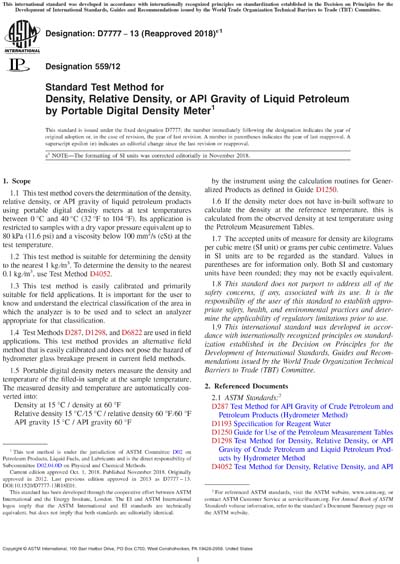Most recent
ASTM D7777-13(2018)e1
Standard Test Method for Density, Relative Density, or API Gravity of Liquid Petroleum by Portable Digital Density Meter
1.1 This test method covers the determination of the density, relative density, or API gravity of liquid petroleum products using portable digital density meters at test temperatures between 0 °C and 40 °C (32 °F to 104 °F). Its application is restricted to samples with a dry vapor pressure equivalent up to 80 kPa (11.6 psi) and a viscosity below 100 mm2/s (cSt) at the test temperature.
1.2 This test method is suitable for determining the density to the nearest 1 kg/m3. To determine the density to the nearest 0.1 kg/m3, use Test Method D4052.
1.3 This test method is easily calibrated and primarily suitable for field applications. It is important for the user to know and understand the electrical classification of the area in which the analyzer is to be used and to select an analyzer appropriate for that classification.
1.4 Test Methods D287, D1298, and D6822 are used in field applications. This test method provides an alternative field method that is easily calibrated and does not pose the hazard of hydrometer glass breakage present in current field methods.
1.5 Portable digital density meters measure the density and temperature of the filled-in sample at the sample temperature. The measured density and temperature are automatically converted into:
Density at 15 °C / density at 60 °F
Relative density 15 °C/15 °C / relative density 60 °F/60 °F
API gravity 15 °C / API gravity 60 °F
by the instrument using the calculation routines for Generalized Products as defined in Guide D1250.
1.6 If the density meter does not have in-built software to calculate the density at the reference temperature, this is calculated from the observed density at test temperature using the Petroleum Measurement Tables.
1.7 The accepted units of measure for density are kilograms per cubic metre (SI unit) or grams per cubic centimetre. Values in SI units are to be regarded as the standard. Values in parentheses are for information only. Both SI and customary units have been rounded; they may not be exactly equivalent.
1.8 This standard does not purport to address all of the safety concerns, if any, associated with its use. It is the responsibility of the user of this standard to establish appropriate safety, health, and environmental practices and determine the applicability of regulatory limitations prior to use.
1.9 This international standard was developed in accordance with internationally recognized principles on standardization established in the Decision on Principles for the Development of International Standards, Guides and Recommendations issued by the World Trade Organization Technical Barriers to Trade (TBT) Committee.
Content Provider
ASTM International [astm]






